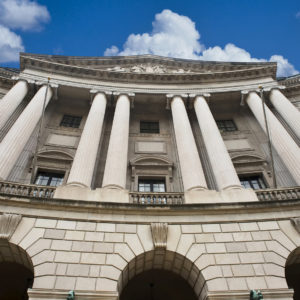When President Donald Trump announced his proposed “America First” budget, Democrats found a lot to complain about. Among the agency budgets that faced harsh cuts was the Environmental Protection Agency, which, under the Trump plan, would have seen its budget cut by 31 percent, and its manpower reduced by 20 percent, or about 3,000 positions. Although Democrats and environmentalists lamented the EPA’s budget cuts and the programs that would inevitably be cancelled, the budget compromise passed by Congress on Wednesday had only a minor impact on the EPA budget, a shift in keeping with the more moderate reforms undertaken by agency head Scott Pruitt.
The America First budget cut EPA funding by $247 million for this year. In the bill which just passed Congress, the EPA instead saw its funding reduced by $80 million, while maintaining the current staffing levels.
May Boeve, executive director of the environmental group 350.org, said in a statement that the EPA budget was “far from the budget that this climate crisis and the communities it impacts requires,” but saw the compromise as a sign that protests like the climate march had been successful.
“This budget deal is proof that people power is our best tool to fight Trump’s climate attacks,” said Boeve. “More than 200,000 turning out for the Peoples Climate March helped save 99 percent of the EPA budget and boost funding for science.”
Environmental groups had protested Trump’s proposed EPA budget cut for weeks. In the end, they found allies in lawmakers who wished to preserve environmental protection programs that benefited their states, including funding for environmental cleanup and clean energy.
The omnibus “reflects the reality there is a lot of support for clean energy,” Gregory Wetstone, president and CEO of the American Council On Renewable Energy, told Bloomberg News. Others saw the final spending bill as a sign that Trump’s more extreme policies would be moderated by Congress.
“It’s a rebuke of the sharp cuts the Trump administration had on the table as priorities,” said Rachel Cleetus, lead economist at the Union of Concerned Scientists. “What’s striking about this deal is that there is a broad bipartisan support, including for funding for the EPA, funding for the Department of Energy’s work on clean energy and other innovations.”
Instead, the new funding bill shows that, so far, the EPA’s new course has been much more moderate than environmentalists had feared. References to human-caused climate change have been removed from EPA websites. A website highlighting the Obama Clean Power Plan has also been replaced with a page highlighting energy independence, following a Trump executive order repealing the plan.
Though the agency escaped without significant funding cuts, Republican lawmakers saw hope for reasonable reform in the budget. North Dakota Congressman Kevin Cramer stressed the budget’s support for defense, agriculture, and other local issues, but also praised the budget for ending funding for the Green Climate Fund, an international fund to help developing nations prepare for climate change.
The budget funds the federal government and the EPA through the end of the fiscal year in September. At this point, in theory, the EPA could be up for further budget cuts. However, various lawmakers have expressed reservations that significant cuts are likely. Sen. Tom Udall (D-N.M.), the ranking member of the Senate Appropriations Committee Subcommittee on Environment, Interior and Related Agencies, told reporters in March that he expected the congressional budget process to include FY2018 cuts, but would not reach the severity of Trump’s initial proposal.
The budget also provided $15 million for the state of North Dakota to reimburse law enforcement costs from the Dakota Access Pipeline protests last year.

